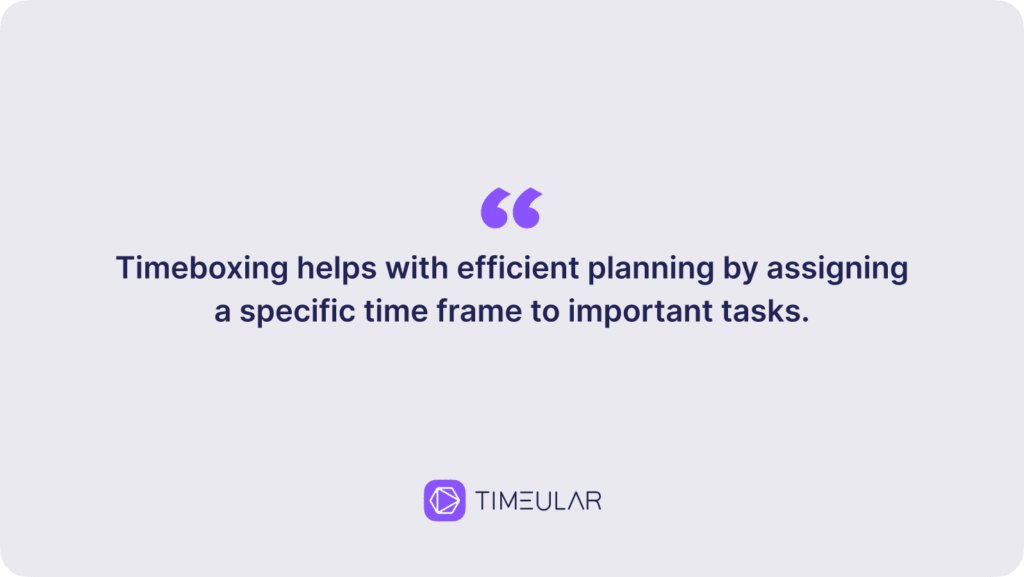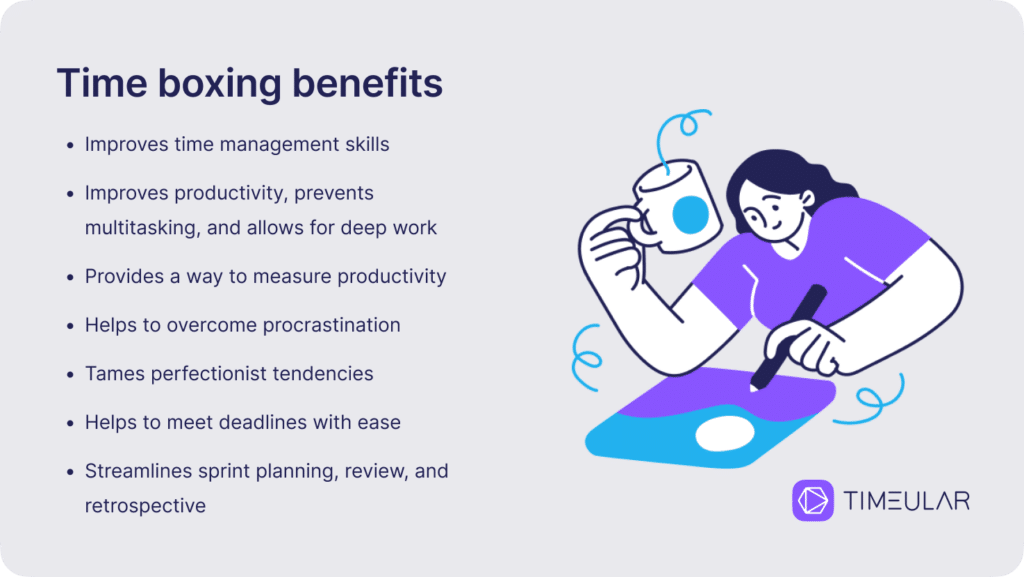Timeboxning: Definition, fördelar och hur det fungerar
Om du letar efter praktiska metoder för att förbättra produktiviteten och få ut det mesta av din tid har du hamnat på rätt sida. I den här artikeln kommer jag att utforska begreppet timeboxning - en av de mest effektiva strategierna för tidshantering som används av framgångsrika team och individer.
Vad du kommer att lära dig:
- Vad är timeboxning?
- Vilka är fördelarna med timeboxning?
- Hur man använder timeboxning och behåller fokus
Jag började använda timeboxning för ett par månader sedan och jag önskar att jag hade vetat det tidigare! Låt oss upptäcka hur en strikt gräns för enskilda uppgifter kan hjälpa även dig att öka fokus och leverera mer på kortare tid.
- Ladda ner nu gratis: Timeboxing-mall
Vad är timeboxning?
Timeboxing, även kallat tidsblockering, är en enkel teknik för tidshantering som används inom Scrum och Agile projektledning. Den hjälper till med effektiv planering genom att tilldela en specifik tidsram till viktiga uppgifter.
Den avgörande aspekten för att lyckas är att behålla fokus på en enda uppgift inom den tilldelade tiden och undvika distraktioner eller byte av sammanhang.

Hur fungerar det? Timeboxningstekniken säkerställer effektiv tidsanvändning och hjälper till att slutföra projektledningsuppgifter inom den maximala tidsenheten, från minuter till veckor eller månader beroende på uppgiftens komplexitet.
Du kan använda timeboxning för att effektivt schemalägga enskilda uppgifter, hjälpa ditt team att organisera sig, hantera ett projekt eller planera möten mer effektivt.
Ett exempel: Låt oss säga att du har en kund som vill ha en strategi för sociala medier, ett projekt som tar cirka 30 timmar att slutföra. För att klara tidsfristen på 10 dagar måste du lägga in tre timmar varje dag. Eller, om du föredrar det, kan du satsa på femtimmarsblock fördelade på sex dagar. Allt handlar om att hitta rätt tidsblock för att få jobbet gjort i tid.
Visste du att... Timeboxningstekniken utnyttjar det psykologiska fenomenet att sätta upp en strikt deadline. Utan sådana deadlines tappar man lätt fokus och viktiga uppgifter tenderar att bli allt mer omfattande, vilket beskrivs i Parkinsons lag.

"Jag har fördubblat mina intäkter tack vare Timeular och lyckats halvera min arbetstid" - Valdemar Alfred, ägare av Valdefar
Fördelarna med timeboxning
Även om timeboxning är en så enkel teknik för tidshantering har den oändligt många fördelar:
- Förbättrar förmågan att hantera tid och hjälper till att spara tid
- Förbättrar produktiviteten, förhindrar multitasking och ger möjlighet till djupgående arbete
- Ger ett sätt att mäta produktiviteten
- Hjälper till att övervinna prokrastinering
- Dämpar perfektionistiska tendenser
- Hjälper till att hålla deadlines med lätthet
- Effektiviserar sprintplanering, sprintgranskning och sprintretrospektiv
Låt oss ta en närmare titt på var och en av fördelarna.

1. Hjälper till att förbättra förmågan att hantera tid och spara tid
Timeboxing lär dig att ta ansvar för din tid, vilket är en av de viktigaste färdigheterna inom tidshantering. Med en strikt begränsning av arbetstiden per vecka eller dag och en uppsättning uppgifter som tar en viss tid, får du ut det mesta av varje timme och ser till att du inte förlorar tid. Istället sparar du tid!
Dessutom hjälper timeboxning i kombination med en tidsregistreringsapp dig att lära dig hur mycket tid specifika uppgifter tar, så att du bättre kan uppskatta tiden för dina projekt och uppgifter i framtiden. Detta förbättrar i sin tur processen med att planera din personliga tid och ditt teams tid.
2. Bidrar till att öka produktiviteten genom djupgående arbete
Timeboxing, eller tidsblockering som det också kallas, kan hjälpa dig att snabbt bocka av saker på din att göra-lista. Hur då? Att arbeta med uppgiften i ett djupt arbetsläge hjälper dig att använda dina mentala resurser på det mest effektiva sättet. När du fokuserar på en enda uppgift behöver hjärnan inte förbruka energi på ständiga fokusbyten, och den sparar kraft för att hantera nästa uppgift.
Dessutom gör en fast tidsperiod för att arbeta med en uppgift och en ordentlig deadline att du rör dig, rör dig, rör dig!
- Rekommenderad läsning: Hur många arbetsdagar är det på ett år?
2. Mäter produktivitet
Timeboxning i kombination med en tidmätare för produktivitet hjälper till att mäta produktiviteten genom att tillhandahålla ett tydligt ramverk för att fördela tid på uppgifter och projekt. Genom att sätta specifika tidsgränser för varje aktivitet kan du och ditt team följa framstegen och utvärdera hur effektivt ni utnyttjar er tid.
Detta möjliggör en mer exakt bedömning av produktiviteten baserat på slutförandet av uppgifter inom de angivna tidsramarna.
3. Förhindrar förhalning
Att ägna tid åt en obehaglig uppgift kräver en hög grad av självdisciplin. Om du inte pressar dig själv tillräckligt mycket kan det sluta med att du skjuter upp det hela dagen eller veckan och fokuserar på andra projekt eller mindre uppgifter istället.
Lyckligtvis är timeboxing en metod för tidshantering som också hjälper till att övervinna prokrastinering.
Det bryter ner även de mest skrämmande uppgifterna till hanterbara bitar. Att sätta en deadline skapar en känsla av att det är bråttom och får dig att känna dig ansvarig för din tid.
En annan viktig aspekt är timeboxningens strukturerade karaktär - den ger dig en färdig plan för dagen som minskar överväldigandet.
5. Tämjer perfektionistiska tendenser
Det sägs att det är bättre gjort än perfekt. Tja, inte för dem med ett perfektionistiskt sinne som tenderar att överkonstruera arbete, för vilka arbetet expanderar och varje uppgift tar mycket längre tid än vad som egentligen behövs. Fråga mig inte hur jag vet det 😉.
Den goda nyheten är att timeboxning hjälper till att bekämpa driften att göra saker perfekt. Det hjälper perfektionister som jag att undvika att spendera för mycket tid på att fatta ett beslut eller avsluta ett projekt. När timern ringer är det dags att ta en kort paus och påbörja en ny uppgift.
6. Hjälper till att hålla deadlines med lätthet
Timeboxing hjälper till att uppskatta deadlines genom att ge insikter om hur lång tid det tar att slutföra vissa uppgifter eller projekt. Detta hjälper team att undvika att lova för mycket och säkerställer att deadlines är realistiska och möjliga att uppnå.
För teamledare underlättar timeboxning också mätningen av tillgängliga resurser för nya projekt. Genom att analysera hur mycket tid teamen kan ägna åt ytterligare uppgifter inom sina befintliga arbetsscheman kan ledarna fatta välgrundade beslut om projektets tidsramar och resursfördelning.

Hur används timeboxing i Agile och Scrum?
Timeboxing är som den hemliga såsen i Agile Software Development och Scrum - det håller saker och ting i rörelse och säkerställer att alla håller sig på rätt spår.
I Agile handlar det om att sätta upp tydliga mål och hålla fast vid dem inom specifika tidsramar. Detta hjälper teamen att undvika stressen med att missa deadlines och håller tempot uppe.
I Scrum är timeboxing inbyggt i processen. Sprintar, som är dessa fokuserade arbetspass, har fastställda varaktigheter för att få arbetet gjort.
Även dagliga Scrum-möten, till exempel sprintplanering eller sprintgenomgång, har tidsgränser, så de måste vara korta och trevliga. Timeboxing handlar alltså inte bara om att hantera tid - det handlar om att hålla hela teamet synkroniserat och se till att saker blir gjorda när de behöver göras.

Hur man använder timeboxningstekniken
1. Uppskatta den tid som behövs för en viss uppgift
Börja med att uppskatta hur lång tid varje uppgift på din att-göra-lista kan ta att slutföra och avsätt en specifik tidsram för den.
Dessa beräkningar bör inkludera raster och buffertperioder för eventuella oväntade avbrott.
Om du har problem med det här steget kan du läsa vår guide om tidsuppskattning.
2. Bestäm hur du ska sprida ditt arbete
Nu måste du schemalägga specifika tidsluckor i din kalender - två timmar, tre timmar eller mer - det är helt upp till dig. Håll bara din deadline i åtanke.
Här kan du införliva andra tekniker för tidshantering, som Pomodoro-tekniken (se till att använda vår gratis Pomodoro-timer). Pomodoro-tekniken är en form av tidsboxning som innebär att man arbetar i 25-minuters segment, följt av en kort 5-minuters paus varje gång.
Som ett alternativ till Pomodoro-tekniken finns det många andra tekniker för tidshantering som du kan använda. Kom ihåg att lägga in pauser i dina fokuseringssessioner. De hjälper dig att hålla energinivån hög.
🎯 Tips: Jag har en 2-timmars tidsbox schemalagd för djupt arbete varje morgon. Det hjälper mig att börja dagen på det mest produktiva sättet. Rekommenderas varmt!
3. Lägg till dina tidsblock i din kalender
Använd en analog eller digital kalender, det som fungerar bäst för dig. På Timeular använder vi Google Calendar, som automatiskt skapar tidsposter i våra tidrapporter (Vill du veta hur det fungerar? Läs mer om automatisk tidrapportering).
När du skapar ett tidsblock i din kalender kan du lägga till en anteckning med en kort beskrivning och förväntade resultat. Men lägg inte för mycket tid på det, det är bara för att hjälpa dig att navigera genom dina uppgifter.
4. Ställ in en timer
Använd larmet i din smartphone eller en app för tidsregistrering för att varna dig när det är dags att avsluta en uppgift och gå vidare till nästa. Att förstå vikten av att stanna exakt när timern går är avgörande för att öka fokus och se till att uppgifterna slutförs inom den tilldelade tiden, vilket understryker tidsboxningens inverkan på slutförandet av uppgifter.
5. Utvärdering och översyn
Vad händer om du inte hinner med uppgiften under den tid som avsatts för den? Varje gång du bockar av en tidsruta bör du utvärdera och se över hur det gick.
Anta att du inte har slutfört den aktuella uppgiften i tid. Granska dina framsteg och försök förstå vad du borde ha gjort annorlunda. Behöver du mer tid för den här typen av arbete? Behöver du planera dina uppgifter i en annan ordning?
Att nå sina mål är inte alltid detsamma som att slutföra uppgiften på en gång. Lösningen ligger i att bedöma dina och projektets behov.
6. Belöna dig själv
Försök att skapa positiva associationer till slutförandet av en uppgift och belöna dig själv!
Denna inställning kommer att motivera dig att bocka av fler uppgifter från din att-göra-lista. Det finns många sätt att belöna sig själv. Att ta en uppfriskande promenad, leka med ett husdjur, äta ett gott och nyttigt mellanmål eller lyssna på lugnande musik är enkla men effektiva sätt att belöna sig själv.

Användbara strategier för en framgångsrik timeboxning
1. Gör dina tidsboxar synliga och färgglada
Färglägg tidsrutorna för att underlätta navigeringen i vecko- eller dagsplanen. Oavsett om du väljer att arbeta med en analog eller digital kalender kan du tilldela olika färger, emojis eller koder till varje tidsbox så att du enkelt kan skilja mellan dem.
2. Definiera typen av tidsboxar
Det finns två typer av tidsboxar: hårda tidsboxar och mjuka tidsboxar. Definiera var och en av dina tidsboxar för att få en bättre överblick över vad som väntar dig under en dag eller en vecka.
En "hard time box" är en fast tidsperiod som ägnas åt en fristående uppgift. Föregående och följande tidsruta är inte relaterade till den hårda tidsrutan.
En soft time box är istället en timebox som ingår i en uppsättning relaterade uppgifter. När en soft timebox är klar finns det en ny som är relaterad till och beroende av den.
Ett exempel på en hard time box kan vara att vara värd för ett Retrospective-möte. En "soft time box" kan i stället vara att undersöka en artikelidé, vilket är en del av den mer omfattande processen att skriva ett innehåll.
3. Åtag dig att hålla dina tidsramar med en strikt deadline
Tänk på timeboxar som möten du har bokat med dig själv. Motstå frestelsen att ställa in dem. Håll dig till timeboxen och respektera dess start och slut.
4. Ställ in en timer
Att ställa in en timer hjälper dig att hålla dig ansvarig för den förväntade tiden som du har satt upp för dig själv och varnar dig när den tiden är slut.
5. Skydda din fokuseringstid
Hemligheten bakom timeboxens effektivitet är att den hjälper dig att fokusera på den aktuella uppgiften. Minimera risken för avbrott när du är mitt i flödet. Stäng till exempel av aviseringar från din telefon och Slack - de är några av de största fienderna till produktivitet på jobbet.
6. Glöm inte att ta pauser
Verktyg för tidshantering eller produktivitetstekniker är utformade för att hjälpa dig att vara produktiv, men du måste komma ihåg att ta hand om din fritid och skydda den. Se till att du tar korta pauser mellan dina tidsboxar: sträck på dig, gå runt en stund eller gör en kort yogasekvens.
7. Integrera din kalender med en tidmätare
Om du använder en tidmätare för att mäta tidsboxar, jämför resultatet av din arbetsdag med den planerade tiden.
Genom att integrera tidmätaren med din kalender ser du hur lång tid det tar att utföra en uppgift och du blir mer exakt i din planering nästa gång.
Vanliga misstag du bör undvika när du tidsboxas
- Byt inte arbetsuppgifter förrän den tilldelade tiden har gått ut
- Respektera tidsgränsen för varje tidsbox. Sträck inte ut eller förkorta den
- Fyll inte din kalender flera gånger i rad utan att ta hänsyn till pauser eller bufferttid
- Glöm inte att anpassa dina arbetsuppgifter till de tider på dygnet då du vanligtvis är som mest produktiv
- När du arbetar med uppgiften ska du inte distrahera dig själv med sociala medier eller Slack-meddelanden
- Glöm inte att ställa in ett alarm för varje tidsruta i din tidshanteringsapp
FAQ om tidsboxning
Vem skapade tidsboxning?
Begreppet timeboxing introducerades av James Martin, en bokförfattare som är känd för sitt arbete med agil mjukvaruutveckling. I sin bok beskriver Martin hur effektivt timeboxing är för att öka produktiviteten och hantera projekt mer effektivt.
Jag har svårt att hinna klart med min uppgift innan tidsramen går ut. Hur löser jag det?
Många människor kan stöta på detta problem redan i början. Det är en del av anpassningsprocessen för timeboxning. Börja med att prova mjuka timeboxar, så att du fortfarande kan slutföra uppgifter om du underskattar hur lång tid de borde ta.
Med tiden, och ju fler tidsramar du sätter upp, kommer du att bli bättre på att uppskatta hur lång tid en uppgift tar. Tidrapportering är också till stor hjälp när det gäller att lära sig hur lång tid en uppgift kommer att ta.
Tänk om timeboxning leder till att jag skyndar på uppgifter och sänker kvaliteten på mitt arbete?
Det är viktigt att vara realistisk när du sätter upp mål för varje tidsbox. Målet med den här tekniken är inte att pressa ut varje uns av produktivitet som du har. Se till att du är realistisk när det gäller hur lång tid arbetet kommer att ta.
Vad händer om mina tidsramar är för korta för mitt projekt?
Det enkla svaret är att göra dina tidsboxar längre i nästa sprint. När du påbörjar din resa med tidsboxar kan det också hjälpa dig att förstå hur du använder tiden och hur lång tid specifika uppgifter tar att dela upp arbetet eller projektet i mindre delar.
Använder Elon Musk timeboxning?
Elon Musk, som är känd för sin exceptionella produktivitet, använder sig av tidshanteringstekniken timeboxing för att optimera sitt arbetsflöde. Genom att tilldela specifika tidsblock för varje uppgift hanterar Musk effektivt distraktioner och behåller fokus, även i pressade situationer.
Med hjälp av timeboxing sätter han tydliga gränser och följer förutbestämda tidslinjer, vilket gör att han kan utföra uppgifter effektivt och hålla sig på rätt spår under hela dagen. Denna teknik spelar en viktig roll för Musks förmåga att navigera i kaos och förbli produktiv i sina strävanden
Vem använder timeboxning?
Elon Musk och Bill Gates använder timeboxning. Den här metoden kan kräva lite ansträngning att bemästra, men den hjälper definitivt till att skärpa fokus och öka produktiviteten.
Den stora behållningen med den här metoden är att den ökar medvetenheten om hur lång tid en uppgift kommer att ta i slutändan.